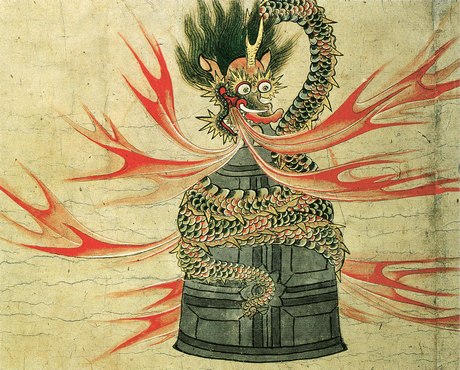|
Musume Dōjōji
''Kyōganoko Musume Dōjōji'' (京鹿子娘道成寺), commonly called ''Musume Dōjōji'' (娘道成寺, "''The Maiden at Dojoji Temple''"), is a kabuki dance drama. It is the oldest surviving Noh-based Kabuki dance drama, which tells the story of a maiden who dances before a bell in the Dōjō-ji temple and then reveals herself to be a serpent-demon. The work is noted for its sequence of dances during which the performer dances for nearly an hour with nine changes of costume. It may be considered the most important piece in the kabuki dance repertoire, one that the onnagatas are required to learn to show their mastery of classic dances. It is classified as one of the ''hengemono'' (変化物, "change pieces") that involve quick change of costumes and roles. Geisha and other dancers may also learn to perform parts of the dance as solo buyō dance pieces. Origin ''Musume Dojoji'' originates from the Noh play '' Dōjōji'' which refers to the tale of a woman later named Kiyohime ... [...More Info...] [...Related Items...] OR: [Wikipedia] [Google] [Baidu] |
Dōjō-ji
is a Tendai school Buddhist temple in the town of Hidakagawa, Wakayama Prefecture, Japan. Founded in the Nara period, it has given its name to a number of plays, most notably the Noh drama '' Dōjōji''. The temple has numerous statues which are designated National Treasures, or Important Cultural Properties, as well as several structures with the Important Cultural Property designation. The precincts of the temple were designated a National Historic Site in 2013. History Although the foundation of the temple is not completely documented, it claims to have been founded in 701 AD at the request of Emperor Monmu, with the monk Gien (643-728) as its founder. According to folklore, Emperor Monmu acted on behalf of his wife, Fujiwara no Miyako, the mother of Emperor Shōmu. According to this legend, Fujiwara no Miyako was born to a family of ''ama'' fishermen in what is now the city of Gobō, Wakayama. Her parents were without children for many years but in response to fervent pra ... [...More Info...] [...Related Items...] OR: [Wikipedia] [Google] [Baidu] |
